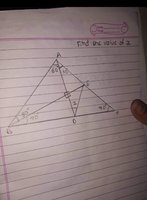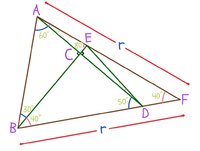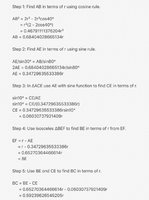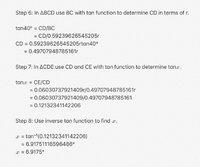You are using an out of date browser. It may not display this or other websites correctly.
You should upgrade or use an alternative browser.
You should upgrade or use an alternative browser.
Find 'x'. I am doing geometry and i got stuck in this question.
- Thread starter exo
- Start date
Dr.Peterson
Elite Member
- Joined
- Nov 12, 2017
- Messages
- 16,604
Dr.Peterson
Elite Member
- Joined
- Nov 12, 2017
- Messages
- 16,604
I've seen many problems similar to this; the angles alone are not sufficient to solve for the unknown angle. It is clear by construction that angle x is determined by the given data, but something involving the actual intersections (and related lengths) is needed to find it.
I expected, based on such problems, that x might turn out to be some nice number like 10 or 20 degrees that could be found by some special insight; but I just constructed it on GeoGebra and found that it is not anything special. I'd try trigonometry next. There are a couple isosceles triangles here, which may help.
I expected, based on such problems, that x might turn out to be some nice number like 10 or 20 degrees that could be found by some special insight; but I just constructed it on GeoGebra and found that it is not anything special. I'd try trigonometry next. There are a couple isosceles triangles here, which may help.
Steven G
Elite Member
- Joined
- Dec 30, 2014
- Messages
- 14,559
So you are saying that 0<x<90 is not correct?I've seen many problems similar to this; the angles alone are not sufficient to solve for the unknown angle. It is clear by construction that angle x is determined by the given data, but something involving the actual intersections (and related lengths) is needed to find it.
I expected, based on such problems, that x might turn out to be some nice number like 10 or 20 degrees that could be found by some special insight; but I just constructed it on GeoGebra and found that it is not anything special. I'd try trigonometry next. There are a couple isosceles triangles here, which may help.
lev888
Elite Member
- Joined
- Jan 16, 2018
- Messages
- 2,995
The outer triangle is defined by 3 angles (well, side lengths are arbitrary). Then you add the 2 lines from the top and left vertices. And finally the 3rd line. No ambiguity anywhere.So you are saying that 0<x<90 is not correct?
Cubist
Senior Member
- Joined
- Oct 29, 2019
- Messages
- 1,686
I think @hoosie has the correct answer.
I tried using the simultaneous equation method suggested earlier but, for me at least, it didn't lead to a solution. ie not linearly independent.
I spotted quite an elegant alternative method (after staring at it for a long time). Using the symbols in Hoosie's diagram...
I tried using the simultaneous equation method suggested earlier but, for me at least, it didn't lead to a solution. ie not linearly independent.
I spotted quite an elegant alternative method (after staring at it for a long time). Using the symbols in Hoosie's diagram...
- Let length CD=d
- BC = d*tan(50)
- AC = BC*tan(30) = d*tan(30)*tan(50)
- CE = AC*tan(10) = d*tan(10)*tan(30)*tan(50)
- angle x = tan-1(CE/CD) = tan-1(tan(10)*tan(30)*tan(50)) ≃ 6.9175




